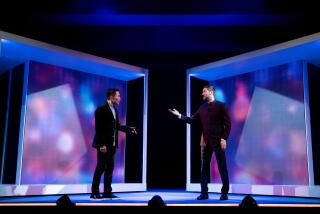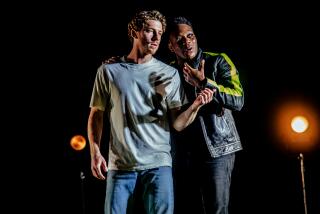Herds Limit ‘Rhinoceros’ Movement
- Share via
BREA — After seeing the first British production of Eugene Ionesco’s absurdist comedy-drama “Rhinoceros,” Noel Coward commented, “I am sick of these amateur pseudo-intellectual scribblings. Ionesco is not a particularly original thinker. He merely tries to be, which is fatal.”
Original Ionesco is not. Absurdist theater goes back to Alfred Jarry’s “Ubu Roi” in 1895, and beyond that to Moliere and the Greeks. Ionesco’s value, like that of his predecessors, was not in his style but, rather, in his use of that style to comment on contemporary society.
His warning in “Rhinoceros,” given an often fascinating but sometimes too loose-limbed revival by the Vanguard Theatre Ensemble at Brea’s Curtis Theatre, is as valid today as it was when it was written in the ‘50s. Following the herd, he said, might just destroy the core of human society and its distinguishing sensibility.
Suddenly a city--Los Angeles in director Duncan Mandel’s concept--is shocked by a rhinoceros rampaging through its streets. An oddity, one character says, because all the animals in the zoo died off years ago.
When a second, and then a third, and then a herd of rhinos begins roaming the city, the citizens realize something is askew, particularly as they begin to recognize friends and neighbors among the herd.
One by one the people turn into rhinos. It’s the thing to do, although the change is ripping apart the fabric of society.
The holdout is Berenger, a distraught, heavy-drinking office worker who can’t accept what’s happening. His friend Jean, who has always approached his business career like a charging pachyderm, succumbs to the plague of “rhinositis.” With Daisy, the love of his life, Berenger begins to believe that they alone must procreate and restart the human race.
Coward was right when he said that Ionesco was not a very good writer. His dialogue is simplistic to a fault, and even the absurdities he cherishes are often forced.
The play asks a lot of its director and actors. The sense of naturalism, the canvas on which Ionesco draws his cartoons, has to be real, or the fun doesn’t work.
Mandel is on solid footing with his leads. Tom Loeprich as Berenger, Michael P. Fahey as Jean, Christopher Sullivan as Dudard and Kirsten S. Vangsness as Daisy all create original characterizations that blend well with the tone of the work.
*
Loeprich’s semi-bitter angst, Fahey’s volatile intensity and Sullivan’s complacent subjectivity are on target. Vangsness’ ditsy opacity is perfect in the final scenes as the action focuses on these characters, but in the crowd scenes she is inclined to edge into a less-effective broadness.
It’s in these large, early scenes that Mandel hasn’t captured the texture of the text. Ionesco wrote in definite rhythms, for an effect, and the rhythms here are usually lost in action involving the sizable supporting cast.
“Rhinoceros” is not an easy play to make work, particularly for audiences not tuned in to the genre. The unevenness at the beginning of this revival is only partially remedied by the forceful treatment of its final moments.
* “Rhinoceros,” Curtis Theatre, Brea Civic Center, 1 Civic Center Circle. Thursday-Saturday, 8 p.m.; Sunday, 2 p.m. Ends Sept. 29. (714) 990-7722. Running time: 2 hours, 5 minutes.
Tom Loeprich: Berenger
Michael P. Fahey: Jean
Kirsten S. Vangsness: Daisy
Christopher Sullivan: Dudard
A Vanguard Theatre Ensemble production of Eugene Ionesco’s absurdist comedy-drama. Produced by Scott Bauer. Directed by Duncan Mandel. Scenic design: Robert Mumm. Lighting design: John Vasquez. Costume design: Ellen King. Makeup/hair design: Susan Mershon. Stage manager: Renee Hill.
More to Read
The biggest entertainment stories
Get our big stories about Hollywood, film, television, music, arts, culture and more right in your inbox as soon as they publish.
You may occasionally receive promotional content from the Los Angeles Times.










